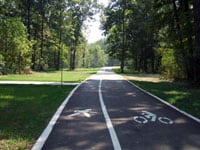One beneficial aspect of marathon training that can't be overlooked is the opportunity to experiment with a variety of miscellaneous concerns (e.g., shoes, nutrition, pacing, etc.) prior to incorporating them into your actual 26.2-mile event. The long run, in particular, is a great time to experiment with various issues in question. A cardinal rule of marathon training is: Don't try anything new on race day. Thus, don't leave anything to chance regarding your strategy on marathon day. Use all training runs as opportunities for experimentation.
Various Areas of Experimentation - Questions in Need of Answers
Shoes
Which type of shoes work best for you? Are you comfortable with the pair you are wearing? How much mileage is currently on them? Will you be able to train in them and still have both ample cushioning/support to absorb the shock your legs will experience during the marathon, keeping discomfort to a minimum while helping protect you from injury?
Socks
Which type of socks (e.g., thin, think, two layers, various materials, etc.) work best for you? There's no worse feeling in a marathon than realizing that your socks are a contributing factor to the development of blisters.
Body Glide/Skin Lube/Vaseline
Should you apply these products? If yes, how much and where should they be applied (e.g., under arms, toes, between legs, nipples, etc.)?
Running Apparel
What type of clothing will enable you to be most comfortable during the marathon (e.g., won't cause chafing, will wick away moisture/perspiration, etc.)? How much and what type of clothing do you need to wear to be comfortable yet not become overheated (e.g., gloves, hat, long-sleeves, etc.)?
Analgesic Cremes
Do you plan to use these types of products (e.g., Ben Gay, Myoflex, Sportscreme, etc.) during the marathon? Some experts claim that they can't penetrate deep enough to relieve muscular discomfort. Others say that are effective in reducing pain and inflammation.
 Pre-Race Evening Meal
Pre-Race Evening MealWhat type of carbohydrate meal do you crave (e.g., pasta, potatoes, rice, etc.)? What foods seem to give you the most energy? What quantities do you need to eat? What time should you eat? Are there any foods that you should avoid so as not to cause digestive problems?
Bed Time
What time do you need to retire to get a good night's sleep?
Wake-up Time
How early do you need to rise to take care of everything you need to do (e.g., eat, drink, visits to the bathroom, etc.)?
What type of foods work best for you, yielding both energy while at the same time, not causing stomach discomfort or cramps?
Coffee/Caffeine
Should you partake? If yes, how much should you drink and how soon before the marathon? Some research suggests that drinking caffeinated products spares glycogen early in a marathon. The flip side is that caffeine is a diuretic and thus may lead to dehydration. The bottom line is that if you choose to consume caffeine, be sure to also drink other fluids to avoid dehydration.
Hydration During the Race
How often do you need to drink fluids during the marathon, and should you consume sports drinks at every aid station?
Should you rely on these as a supplemental energy source during the marathon? There are many types of gels (e.g., brands, flavors) to choose from now. The key is finding the particular product that works for you. Training runs are great opportunities to decide how many packets you will need to consume during the marathon, when should they be taken (at what mile markers/elapsed marathon time), along with determining whether they will cause stomach discomfort.
Race Pace
What is your pacing plan for the marathon? If you wish to run a competitive event, what is the maximum pace you can sustain without hitting the wall.








